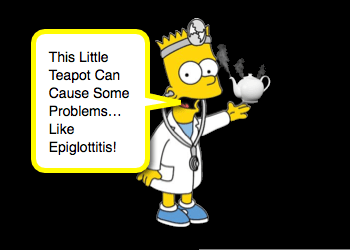Epiglottitis

Epiglottitis: Basics
- Potentially life-threatening condition due to acute airway compromise.
- Epiglottitis = inflammation of the epiglottis and surrounding tissues.
- Can lead to airway obstruction and subsequent respiratory arrest.
Epiglottitis: Causes of the Swelling
Anything that causes edema of the epiglottis can lead to the condition. [Richards, 2016]
- Infection
- Haemophilus influenza type B
- Was the most common cause prior to initiation of Hib vaccinations
- Now it accounts for ~1 case per 100,000 kids. (YEAH IMMUNIZATIONS!)
- Group A and F Streptococci [Faden, 2006]
- Strep pneumonia
- Klebsiella sp
- Staphyloccocus aureus (including MRSA)
- Haemophilus influenza type B
- Thermal Burn
- Can be due to inhaled hot steam. [Kudchadkar, 2014]
- Heat-carrying capacity of steam is 4000 times that of heated air. [Kudchadkar, 2014]
- Quickly can overcome the cooling effects of the upper airways. [Kudchadkar, 2014]
- Leads to mucosal edema that develops over time.
- Trauma
- Caustic Ingestions
Epiglottitis: Presentation
- With the location of the epiglottis, symptoms are classically:
- Sore Throat
- Dysphagia and subsequent Drooling
- Muffled Voice
- Stridor
- Progressive Respiratory distress
- Tripod positioning
- Anxiety (I’d also be anxious if I couldn’t breath)
- Fever and Toxic appearance
- Similar presentation can be seen with bacterial Tracheitis.
- Classically, epiglottis that is caused by infections has an abrupt onset.
- Other causes, like thermal burns from steam, can lead to a gradual onset of symptoms.
Epiglottitis: Management
- Make every effort to keep child comfortable.
- Anxiety will worsen stridor
- More turbulent airflow will occur
- Increased work of breathing
- Delay IV attempts or IM injections
- Do not use tongue depressor as this may worsen agitation.
- Anxiety will worsen stridor
- Call your friends
- You know… your surgeons, your anesthesiologists, and your ENT docs.
- Direct visualization of the epiglottis is the only way to confirm or rule-out the condition.
- This should be done in an area where the child can be kept comfortable and where an emergent surgical airway can be performed.
- Classically, this is an operating room.
- Images?
- Again, the only way to truly rule in or rule out the condition is via direct visualization, but…
- Plain films may be helpful to evaluate for foreign bodies.
- Plain film may also show a “thumbprint” sign – swollen epiglottis.
- Intubation?
- Hopefully can be avoided, but may be necessary.
- Expect to use smaller ETT size than age would predict.
- Be prepared for circothyrotomy and transtracheal needle ventilation.
- Medications?
- No proven benefit (or harm) of steroids.
- No proven benefit of racemic epinephrine (although it may further agitate the child).
Moral of the Morsel
- Epiglottitis may be rare, but it still occurs. Know what to do.
- Epiglottitis is not always caused by infection. Thermal burns, trauma, and caustic burns can lead to airway disasters also!
References
Richards AM1. Pediatric Respiratory Emergencies. Emerg Med Clin North Am. 2016 Feb;34(1):77-96. PMID: 26614243. [PubMed] [Read by QxMD]
Kudchadkar SR1, Hamrick JT1, Mai CL2, Berkowitz I1, Tunkel D3. The heat is on… thermal epiglottitis as a late presentation of airway steam injury. J Emerg Med. 2014 Feb;46(2):e43-6. PMID: 24113478. [PubMed] [Read by QxMD]
Faden H1. The dramatic change in the epidemiology of pediatric epiglottitis. Pediatr Emerg Care. 2006 Jun;22(6):443-4. PMID: 16801849. [PubMed] [Read by QxMD]


[…] Thermal irritation […]
Whilst tracheitis is a differential for epiglottitis, tracheitis usually has a prominent cough and appears like a “toxic croup”, if you will, whereas a cough is not a common feature in epiglottitis. Both are serious conditions that require careful handling of the patient, senior input, IV antibiotics and often intubation.